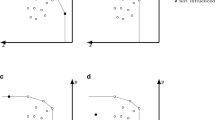Abstract
This paper provides diagnostic tools for examining the role of influential observations in Data Envelopment Analysis (DEA) applications. Observations may be prioritized for further scrutiny to see if they are contaminated by data errors; this prioritization is important in situations where data-checking is costly and resources are limited. Several empirical examples are provided using data from previously published studies.
Similar content being viewed by others
References
Aly, H.Y., R.G. Grabowski, C. Pasurka, and N. Rangan. (1990). “Technical, Scale, and Allocative Efficiencies in U.S. Banking: an Empirical Investigation.”Review of Economics and Statistics 72, 211–218.
Andersen, P., and N.C. Petersen. (1989). “A Procedure for Ranking Efficient Units in Data Envelopment Analysis.” Unpublished working paper, Department of Management, Odense University, Odense, Denmark.
Andrews, D.F., and D. Pregibon. (1978). “Finding the Outliers that Matter.”Journal of the Royal Statistical Society Series B, 40, 85–93.
Burgess, J.F. Jr., and P.W. Wilson. (1993). “Technical Efficiency in VA Hospitals,” inThe Measurement of Productive Efficiency: Techniques and Applications, (eds. Harold O. Fried, C.A. Knox Lovell, and Shelton S. Schmidt), Oxford: Oxford University Press, 335–351.
Charnes, A., W.W. Cooper, and E. Rhodes. (1981). “Evaluating Program and Managerial Efficiency: An Application of Data Envelopment Analysis to Program Follow Through.”Management Science 27, 668–697.
Charnes, A., W.W. Cooper, and R.M. Thrall. (1986). “Identifying and Classifying Scale and Technical Efficiencies in Data Envelopment Analysis.”Operations Research Letters 5, 105–116.
Charnes, A., W.W. Cooper, and R.M. Thrall. (1991). “A Structure for Classifying and Characterizing Efficiency and Inefficiency in Data Envelopment Analysis.”Journal of Productivity Analysis 2, 197–237.
Charnes, A., S. Haag, P. Jaska, and J. Semple. (1992). “Sensitivity of Efficiency Classifications in the Additive Model of Data Envelopment Analysis.”International Journal of Systems Science 23, 789–798.
Charnes, A., and L. Neralić. (1990). Sensitivity Analysis of the Additive Model in Data Envelopment Analysis.”European Journal of Operational Research 48, 332–341.
Chatterjee, S. and Hadi, A.S. (1986). “Influential Observations, High Leverage Points, and Outliers in Linear Regression.”Statistical Science, 1, 379–392.
Cook, R.D., and S. Weisberg. (1982).Residuals and Influence in Regression. New York: Chapman and Hall.
Deprins, D., L. Simar, and H. Tulkens. (1984). “Measuring Labor Inefficiency in Post Offices.” inThe Performance of Public Enterprises: Concepts and Measurements, (ed. M. Marchand, P. Pestieau, and H. Tulkens), Amsterdam: North-Holland, 243–267.
Dusansky, R. and P.W. Wilson. (1994). “Measuring Efficiency in the Care of the Developmentally Disabled.”Review of Economics and Statistics 76, 340–345.
Dusansky, R. and P.W. Wilson, (1995). “On the Relative Efficiency of Alternative Modes of Producing Public Sector Output: The Case of the Developmentally Disabled.”European Journal of Operational Research 80, 608–628.
Färe, R., S. Grosskopf, and C.A.K. Lovell. (1985).The Measurement of Efficiency of Production, Boston: Kluwer-Nijhoff.
Färe, R., S. Grosskopf, and C. Pasurka. (1986). “Effects on Relative Efficiency in Electric Power Generation Due to Environmental Controls.”Resources and Energy 8, 167–184.
Gray, J.B. (1988). “A Classification of Influence Measures.”Journal of Statistical Computation and Simulation, 30, 159–171.
Greene, W.H. (1980). “Maximum Likelihood Estimation of Econometric Frontier Functions.”Journal of Econometrics 13, 27–56.
Grosskopf, S., and V. Valdmanis. (1987). “Measuring Hospital Performance.”Journal of Health Economics 6, 89–107.
Gunst, R.F., and R.L. Mason. (1980).Regression Analysis and its Application. New York: Marcel Dekker.
Korostelev, A. P., L. Simar, and A. B. Tsybakov. (1994). “Efficient Estimation of Monotone Boundaries.”Annals of Statistics, forthcoming.
Lovell, C.A.K. (1993). “Production Frontiers and Productive Efficiency.” inThe Measurement of Productive Efficiency: Techniques and Applications, (eds. H. Fried, C.A.K. Lovell, and S. Schmidt), Oxford: Oxford University.
Lovell, C.A.K., L.C. Walters, and L.L. Wood. (1993). “Stratified Models of Education Production Using DEA and Regression Analysis.” inData Envelopment Analysis: Theory, Methods, and Applications, (eds. A. Charnes, W.W. Cooper, A.Y. Lewin, and L.M. Seiford). New York: Quorom Books.
Martin, J.P. and J.M. Page. (1983). “The Impact of Subsidies on X-efficiency in LDC Industry: Theory and an Empirical Test.”Review of Economics and Statistics, 65, 608–617.
McCarty, T.A., and S. Yaisawarng. (1993). “Technical Efficiency in New Jersey School Districts.” inThe Measurement of Productive Efficiency: Techniques and Applications, (eds. H. Fried, C.A.K. Lovell, and S. Schmidt), Oxford: Oxford University.
Rousseeuw, P.J., and G.W. Bassett. (1991). “Robustness of the p-Subset Algorithm with High Breakdown Point.” inDirections in Robust Statistics and Diagnostics: Part II, (eds. W. Stahel and S. Weisberg), New York: Springer-Verlag.
Rousseeuw, P.J., and B.C. van Zomeren. (1990). “Unmasking Multivariate Outliers and Leverage Points,”Journal of the American Statistical Association, 85, 633–639.
Seaver, B.L., and K.P. Triantis. (1989). “The Implications of Using Messy Data to Estimate Production-Frontier-Based Technical Efficiency Measures.”Journal of Business and Economic Statistics 7, 49–59.
Sexton, T.R., R.H. Silkman, and A.J. Hogan. (1986). “Data Envelopment Analysis: Critique and Extensions,” inMeasuring Efficiency: An Assessment of Data Envelopment Analysis, R.H. Silkman (ed.), San Francisco: Jossey-Bass Co.
Shephard, Ronald W. (1970).Theory of Cost and Production Functions, Princeton: Princeton University.
Thrall, R.M. (1993). “Duality, Classification, and Slacks in DEA.” Unpublished working paper, Jones Graduate School of Administration, Rice University.
Timmer, C.P. (1971). “Using a Probabilistic Frontier Production Function to Measure Technical Efficiency.”Journal of Political Economy 79, 776–794.
Welsch, R.E. (1982). “Influence Functions and Regression Diagnostics.” inModern Data Analysis, (ed. by R.L. Launer and A.F. Siegel). New York: Academic Press.
Wilson, G.W., and J.M. Jadlow. (1982). “Competition, Profit Incentives, and Technical Efficience in the Provision of Nuclear Medicine Services.”The Bell Journal of Economics 13, 472–482.
Wilson, P.W. (1993). “Detecting Outliers in Deterministic Nonparametric Frontier Models with Multiple Outputs.”Journal of Business and Economic Statistics 11, 319–323.
Author information
Authors and Affiliations
Additional information
This research was performed while under contract with the Management Science Group, U.S. Department of Veterans Affairs, Bedford, MA 01730. Shawna Grosskopf and Richard Grabowski graciously provided data used in two of the empirical examples.
Rights and permissions
About this article
Cite this article
Wilson, P.W. Detecting influential observations in data envelopment analysis. J Prod Anal 6, 27–45 (1995). https://doi.org/10.1007/BF01073493
Issue Date:
DOI: https://doi.org/10.1007/BF01073493




